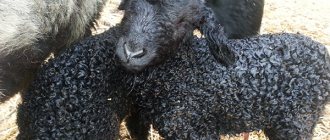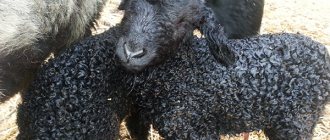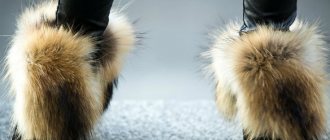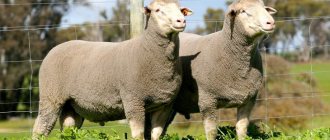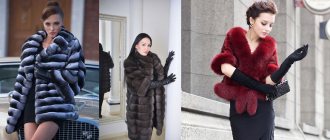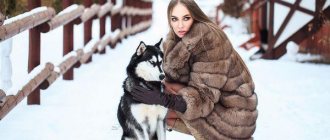Eurofur - modern insulation for women's winter boots
Most often, women's winter boots are insulated with eurofur.
Such boots not only warm you well, but also preserve (emphasize) the slimness of your legs in the most important place. Between ankles and knees. In “ordinary” boots with fur, high-quality natural insulation (sheepskin + sheepskin) thickens the legs by 1.5 - 2 cm. Many young ladies do not like this, even with slender legs. At the same time, the warming properties of boots with Eurofur are practically not inferior to boots with fur insulation “from top to bottom.” It is important that the fur in the shoes warms the toes and feet, and its presence on the boot is not necessary. The calves and ankles are reliably warmed by the blood flow and do not require additional insulation until the legs freeze at the very bottom. To freeze in boots with Eurofur, the air temperature required is lower - 15º - 18º. If you don’t stand in the cold without moving, then decent boots with decent Eurofur insulation will keep you warm even at -20º and below.
Shoe manufacturers from Asian countries and some unworthy Belarusian factories, in order to save money, prefer to use artificial fur in boots with European fur. To identify such products, you have to turn the boot inside out, which is not always possible in a store environment. It should be remembered that artificial, or more correctly speaking, synthetic fur, is a complex product of the petrochemical industry. It includes strong allergens and simply toxic substances. Which, during wear, are absorbed through the skin into the human body, causing over time serious diseases, including cancer.
In a similar way, merchants deceive customers - scammers who use fake, freshly invented words. Pointless and misleading to customers. For example, “Eurowinter”. As a rule, such “terms” are used by importers of the most short-lived and toxic boots made in China. With non-heating and poisonous “fish fur” insulation, cheap and useless synthetic insulation in the Russian frost on a leatherette backing - “dermantine”.
These crooks, as a rule, hide under fictitious pseudo-Italian names. They hope in this simple way to facilitate the “almost legal taking of money” from not very knowledgeable girls and ladies. In reality, in Italy they almost never produce winter boots made of natural fur on a trench coat. Shoemakers in countries with a warm Mediterranean climate do not have such traditions, and such boots will be very expensive. It’s very easy to identify scammers - just type in the English name of the “famous Italian brand” into Google or Yandex. If the manufacturer really exists and is actually from Italy, then an organic (NOT ADVERTISING!) search in 1-3 places in the search results (not lower!) will show a link to the official website of the manufacturer. The site will necessarily be IN ITALIAN in the .it or .com/it domain. For example https://www.gucci.com/it. If a “reputable Italian brand” does not have a website in Italian at all, or the “Italian” website consists of a single page with template text without a selector and internal navigation, a “patch” in the jargon of web designers (such fake “pseudo Italians” in the shoe world approximately 95%), then draw the right conclusions and do not give money to scammers. Shoes from the multiplied “Paola Carlobiani” from a dirty Chinese basement will not last long. In this case, the “brand” was invented by slippery local marketers, and the shoes are produced in the cheapest and most miserable contract factories in China, Vietnam or Bangladesh. Made from the most fragile, short-lived and hazardous materials. And you shouldn’t believe the rave reviews about the wonderful boots “from Dino Dulberducci.” They are written under the nicknames Varvar from Tambov and Galin from Belarus by the same cunning marketers who came up with these “dulberducci”. This has long been no secret to anyone.
The Bonti company sells shoes only from high-quality natural fur produced in the European Union. In accordance with strict sanitary and environmental standards. The upper part of the boots with Eurofur is insulated with flannel, which warms better than flannel. Therefore, our shoes can be worn without fear, including by pregnant women. There is also a “lighter” option for insulating boots - Eurowool. Check out our online store with free delivery throughout Russia. Or come to our offline salon in Perlovka, at the intersection of the Moscow Ring Road and Yaroslavskoye Highway. Our assortment, quality and prices speak for themselves, especially in comparison with the contents of most Moscow shoe stores.
Advantages of Eurofur | Shoes
Everything new is frightening with the unknown, but those who dared and risked putting on Eurofur managed to appreciate its advantages and high insulating characteristics.
Having outerwear made of natural fur, you don’t have to worry about the warming properties of the things you wear underneath. The only item of clothing that requires a certain appearance and warming qualities is shoes.
And since your feet must be warm, when choosing boots you need to pay special attention to the interior decoration. For winter boots, the most important factor is the ability to keep your feet and toes warm and comfortable and dry. At the same time, it is equally important for every fashionista that the appearance, style or model be as fashionable and modern as possible.
The best material used for insulating winter shoes today is Eurofur, more details on the website www.fursk.ru. High-quality natural fur, processed using modern European technology.
This material is most often used to insulate tall women's boots and boots. Many manufacturers use Eurofur to trim the insides of ugg boots and boots of a similar cut.
Shoes that use such insulation have good reviews and are quite popular among consumers. A significant advantage is its cost.
The price of products insulated with Eurofur is much lower than similar ones using tsigeyka. And the best part is that this does not reduce quality indicators at all.
For a harmonious appearance and completeness of the image, a lady in a long, chic fur coat can put on a long boot, the inner insulation of which up to the ankle is Eurofur, and the boot is trimmed with thin flannel. The warmth of natural fur is enough to warm the entire length of the foot and only the foot requires additional warmth from the shoe.
And the flannel inside of the boot does not weigh down the shape of the leg and does not overheat it under the fur coat. An excellent model for slippery roads and suitable for short fur coats and short fur coats can be boots with low tread soles with Euro fur to insulate the foot.
In such a boot it will be very warm and safe to walk on frozen sidewalks. The combination of a natural fur coat with original, almost primitive ugg boots looks very young and stylish. Incredibly comfortable and warm shoes insulated with Eurofur will keep your feet from freezing in the most severe Russian frosts.
Eurofur - what is it? Advantages and disadvantages
With the onset of cold weather, almost every woman goes to the store to buy shoes. Today's choice is huge, something new is constantly appearing. Recently, Eurofur has become very popular. We will look at what this is in this article.
Perhaps many have heard, but not everyone knows what European fur in boots is. For most women this word is unusual. But in reality everything is quite simple.
Manufacturers so call those shoes in which only the lower part is insulated - in the area of the foot. Such boots originally appeared in Europe, since winters there are milder and not so cold, hence the name.
Such shoes are very convenient to wear in the off-season, when it is not yet warm enough, but there are no longer severe frosts. But you don’t have to think that you don’t wear Eurofur in winter. Many people know what it is. These shoes have many fans. Eurofur, according to customer reviews, is lighter and the shoes look more elegant. For example, classic winter boots, which are fully insulated, have the following drawback - they visually make the foot wider by several centimeters. For many ladies, this fact is critical. In boots with eurofur, your legs look more impressive. These shoes are easy to fasten, because there is only a thin lining on the boot, which is a clear plus for lovers of denim trousers.
Where to buy women's boots
The online store PLANET OF FOOTWEAR offers German and Finnish boots at low prices. Boots from the fall-winter 2016/17 fashion collection. Suede and leather women's boots from sizes 33 to 44. If you don’t yet know where to buy boots, we invite you to our stores. You will be pleasantly surprised by the range and prices for the collection of women’s boots. So, don’t waste time. After all, boots for any stylish woman are the sleigh that you definitely need to prepare in the summer. So, go shopping while there is a large selection and prices are not so high. Remember, it is shoes that create a woman’s image, and your shoes must be impeccable!
How well do they heat?
Many buyers are interested in whether such shoes will be warm in winter. Of course, in severe frost it is better to wear warmer boots or shoes, but at 10-15 degrees, Eurofur retains heat well.
There are two types of fur used in European shoes: artificial and natural. Yes, natural is warmer and more practical, and this is another plus of Eurofur. After all, in such boots it is located only in the lower part, which means they will be cheaper than classic ones.
Judging by reviews on the Internet, for many women the question of whether to wear Eurofur has long been irrelevant. Many people know what it is - Eurofur, appreciate it and are ready to use it again and again. After all, such shoes are not only cheaper, they are quite warm and look much more elegant on the foot. Today's selection of models allows any woman to choose a pair to suit her taste and remain satisfied.
Fur and wool (woolen fur) as insulation for winter shoes
What is it and what is the difference between fur and wool?
- Shoe insulation is fur (natural fur and/or eurofur), in its honest interpretation, is tanned sheep skin (tsigeyka) with the hair retained as much as possible. Everyone has seen sheepskin coats - this is a complete analogue of good fur shoe insulation. Other insulation materials cannot be called fur; this is a direct deception of buyers. In the same way, people are being deceived by the proliferating swindlers - marketers - copywriters and other deceitful bloggers and fashion observers who have come up with a lot of false terms like “Eurowinter”, “faux fur”, “fish fur”, “wool fur” and other “eco-leathers”. It is advisable to avoid Chinese, Vietnamese, Thai and Bangladeshi “shoe crafts”, where the lowest-grade sheepskin is shamelessly stretched in a steamed state and abundantly impregnated with toxic and carcinogenic chemicals, so that the thin and rare fur does not come out in the first 1-2 months. For organoleptic quality control, it is enough to turn out the “tongue” of the shoes and carefully evaluate the thickness of the insulation, as well as sniff the shoes.
- Wool shoe insulation, often incorrectly referred to as “wool fur,” is a mixture of natural wool and synthetic fibers tightly fused to a flexible and breathable textile backing. Externally, wool is often very similar to “normal fur”, but shoes with such insulation are much lighter, more elegant, more practical and, of course, cheaper than “fur” ones. It is important to understand that wool insulation is not a fake “fur” and not an attempt to save on the heat-protective qualities of winter shoes, but a high-quality, effective, environmentally friendly and durable modern insulation for winter shoes, especially urban ones. High-quality wool, for example, here in Bonti, performs its functions perfectly for 3-4 years. And at the same time, shoes with wool insulation are much better able to withstand wear and tear and improper care than fur ones.
In what cases (conditions) is it preferable to choose one or another insulation?
- High-quality fur insulation in WORTHY EUROPEAN FOOTWEAR is “warmer” than wool, that’s obvious. Fur-lined shoes are the right choice for retirees with constantly cold feet. For residents of the northern, Ural and Siberian regions, where winters are (still) real and where winter temperatures “keep” below -15°C for a long time, it is also advisable to have 2 pairs of winter shoes with fur. At the same time, the capabilities of even high-quality fur shoes should be adequately assessed. For example, if you have to spend a LONG TIME (more than 1.5 - 2 hours) outside without moving and/or the temperature “outside” is below 25°C, then even decent shoes with fur will not save your toes from freezing. In such cases, it makes sense to use felt boots or high boots. In addition, it is important to remember that decent fur shoes consist of 2 layers of leather (outer and inner) and natural fur. If there is only one layer of leather, then such shoes have no right to be called winter and good-quality. An example is the impractical, short-lived, traumatic and “cold” Ugg boots - a wretched idea of vile traders, actively imposed on weak-minded “trend girls”.
- Shoes with wool insulation are more practical than their fur counterparts; they “have the right to be” when the use of shoes with fur is inappropriate from the point of view of resistance to wear and wetting, excessive thermal protection and hygienic parameters, for example:
- If “outside” it is warmer than -15°C, then fur-lined shoes are simply not needed, but that’s not all. The feet in it actively overheat, sweat, get wet and exude the “patented aroma” of the old and new felt boots of the janitor Tikhon from the immortal “12 chairs”.
- When there is no need to be in the cold for a long time without moving, then there is also no point in using shoes with fur. In the process of walking and/or for 15-20 minutes, the feet simply do not have time to freeze even at -20°.
- When you have to wear the same pair of winter shoes every day. Shoes with fur should absolutely not be dried using any heat sources. In the humid climate of the central regions of Russia, it takes at least 20 hours for fur to fully dry, which precludes its continuous use. Shoes made with wool are guaranteed to dry in 8-10 hours in the natural conditions of any heated premises (except bathrooms and toilets).
- When it is not possible to change shoes in a warm room. For students, this limitation is especially important.
- High-quality shoes with wool insulation are much cheaper than their counterparts, insulated with full-fledged fur on the fleece.
- Wool insulation is thinner than fur and does not absorb or accumulate sweat and water. Therefore, shoes made of wool are objectively more elegant and fashionable than fur ones.
We at Bonty do not set ourselves the task of persuading customers and “pulling” them into one or another “camp”. In our assortment there is and will be approximately equal number of winter models with natural fur and wool insulation. Our goal is to provide people with reliable information, objective facts, on the basis of which they can make a thoughtful and beneficial choice. This is how we differ from the prostituted “crowd” of bloggers, advertisers, self-proclaimed fashion “experts” and other useless “humanitarian riffraff.” ©
www.bonty.ru
How to choose the right one
The selection rules are exactly the same as for regular winter shoes. First you need to decide on the material. Of course, the leader is genuine leather, it is practical, lasts a long time and retains heat well. Suede is also good, but it requires special care, and you can’t really walk in it in wet weather. A cheaper material is artificial leather, which is slightly inferior in quality to the first two, but compensates for this with its low cost.
After choosing a specific model, it is advisable to inspect all the fittings for defects. And special attention should be paid to the sole; it should be thicker than one centimeter and made of rubber or polyurethane; these materials are wear-resistant and well suited for winter. And the larger and better the relief is drawn, the less slippery the boots will be.
In addition to questions about why Eurofur is used, what it is and how warm it is, many advantages of such shoes were considered. We can conclude that a woman’s wardrobe should have several types of boots for any occasion, including those with Euro fur.
Eurofur in Italian
Experienced shopaholics know that the concept of winter boots in Italian is sometimes significantly different from what we, Ukrainians, know about winter shoes . If good-quality fur and durable soles are the main indicators of quality for us, then “winter Italy” has its own nuances. We must not forget that Italy is predominantly a Mediterranean country with a mild climate; severe “Siberian” frosts are known here only hypothetically. Therefore, winter shoes for the domestic market are modeled and sewn in a lightweight version; instead of fur, wool, flannel, and various innovative materials are often used. The Eurofur variant discussed above is also used. Although it is also known that some manufacturers have separate lines for sewing “real” winter shoes for export, this is more the exception than the rule.
Considering these features, when choosing Italian winter boots (and any other shoes), it is extremely important to examine its “insides” and find out what temperature indicators this or that model is oriented towards. We should also not forget that the current winters increasingly resemble a state of constant compromise between the desire to look beautiful and suit the weather. Having the same boots for the whole winter is absolutely unacceptable, especially if we are talking about a product from an Italian brand. Even the most branded boots cannot withstand our weather collapse.
Fortunately, there is no shortage of shoes now; the main thing is to approach the choice correctly and wisely. Eurofur models have been deservedly popular among our compatriots for several years now; they can well serve as both an alternative and a complement to the winter wardrobe. According to official data, they are comfortable at temperatures not lower than 4-5 degrees below zero, but many young ladies claim that it is quite possible to last in Eurofur boots all winter, especially if you have the opportunity to travel by car.
Eurofur - what is it?
In fact, this is not the skin of any animal, it is a way to insulate shoes.
With it, the foot in a boot up to the ankle is as if in a fur sock, and then a fabric lining is placed up to the very top. Eurofur is not a material, but a method of insulation, in which the lower part of the leg - foot, ankle - is warmed by fur, and on the ankle the nature of the insulation changes to a fabric lining - flannel or fleece .
Is it warm?
Cold weather is ahead, and therefore a natural question arises about whether it is warm in such boots and at what temperature the foot will feel comfortable. Natural materials act as insulation for the lower part: sheepskin or sheepskin. Above there is insulation with soft fleece. To keep warm in winter, it is enough for your feet to warm up .
The upper part of the boot will maintain the temperature at which the shoes were fastened indoors. With active movement, for example, walking, such shoes will keep you warm even in frosty winters of up to 20 degrees. But if on the street the thermometer drops significantly lower, then you will need shoes that provide warmth up to the knee: boots with natural fur, felt boots, high boots.
What weather is it designed for?
The foot below is insulated with natural fur, which means these are not demi-season shoes. Boots with Eurofur are sold as a lightweight winter option and are designed for use in different weather conditions .
What kind of weather are shoes with eurowool designed for?
These shoes are suitable for both winter and off-season. The combined method of insulation prevents the legs above the ankles from overheating. As experiments show, in cold weather it is important that wool in shoes warms the feet, and its presence on the boot is not necessary.
The shins receive enough heat through the bloodstream, thanks to tights, pants, leather boots, etc. Thus, boots with eurowool are quite warm and also provide comfort during long-term wearing. They will be the best option in the Ukrainian winter, when the morning is frighteningly cold, and during the day, especially in transport and indoors, the temperature rises.
Pros and cons of Eurofur in boots
Based on the foregoing, we conclude that Eurofur is suitable for many situations and has undoubted positive aspects:
- There is no voluminous fur in the upper part of the boot; here it is replaced with thinner fleece or flannel. Accordingly, the volume does not increase, and the legs remain slender ;
- shoes are lightweight, since fleece is much lighter than natural fur;
- thin lining makes fastening easy;
- the presence of fur only in the lower half of the boot significantly reduces the cost compared to shoes consisting entirely of natural materials.
Despite all the positive aspects, there are also some negative aspects:
- such fur does not provide sufficient protection from severe frosts;
- Often in shoes called “Eurofur”, unscrupulous manufacturers replace natural materials with synthetic analogues that are externally difficult to distinguish from the proper fur and leather .
- Having considered all the pros and cons of shoes with Euro fur, we can conclude that such options are in demand in the women's wardrobe.
Which of these options is more comfortable and healthier for children's feet?
Myth No. 3. Natural materials are always better than artificial ones.
We have already said above that with increased activity, the right combination of synthetics and natural wool copes with the cold best. But this is not the only advantage of combined materials. They also win by:
- cost,
- wear resistance,
- drying time,
- ease of care,
- weight
Woolen and wool-blend fur is lighter and takes up less space - shoes put less strain on your feet and look more elegant. It dries 2 times faster and can be washed and dried, unlike natural fur. Also, half-woolen fur does not prick - this is important for small, delicate legs.
What is added to Eurofur in boots?
Sometimes, instead of Eurofur, you can hear the term Eurowool.
This is also one of the ways to insulate a boot, only the natural fur in the shoes is replaced with high-quality sheep wool, processed using a special technology. The name euro determines that this product was created and in demand in the European Union . In our country, boots with such insulation have not yet become widespread. But in Sweden, Denmark, Germany and other countries they have long appreciated this invention and wear similar models with success.
To create Eurowool, raw materials are taken from special breeds of sheep. Their fur is denser than usual. It practically does not fall off, and the processing technology used ensures thermal stabilization throughout the entire period of operation .
As a result, the resulting material is resistant to abrasion and creasing, and will also easily ensure the stability of the thermal insulation of shoes during any period of use. Feet in such shoes do not sweat. This is guaranteed by good ventilation and lower moisture holding capacity compared to natural fur.
Boots
Country of manufacture: CHINA Upper material: Natural suede Lining material: Eurofur Insole material: Natural fur Color: Black Seasonality: Winter.
Read more
Orders are now accepted
See similar products that you can order right now
RUR 399.
Children's boots, painted “Umka”. PVC material. Color options: blue. Shoe height 18cm. Without...
24(142mm), 25(150mm), 26(157mm), 27(165mm), 28(172mm)
435 rub.
1 order
Children's boots, painted “Umka”. PVC material. Color options: blue. Shoe height 22cm. Insulated…
29(180mm), 30(187mm), 31(195mm), 32(202mm), 33(210mm), 34(217mm), 35(225mm)
490 rub.
1 order
Children's colored boots “Umka”. PVC material. Color options: assorted designs. Height about...
24(142mm), 25(150mm), 26(157mm), 27(165mm), 28(172mm)
526 rub.
Colored children's boots “Umka”. PVC material. Color options: assorted designs. Shoe height...
29(180mm), 30(187mm), 31(195mm), 32(202mm), 33(210mm), 34(217mm), 35(225mm)
462 rub.
Children's boots, painted “Umka”. PVC material. Color options: blue. Shoe height 18cm. With ute...
24(142mm), 25(150mm), 26(157mm), 27(165mm), 28(172mm)
499 rub.
1 order
Children's boots, painted “Umka”. PVC material. Color options: blue. Shoe height 22 cm. Without insulation…
29(180mm), 30(187mm), 31(195mm), 32(202mm), 33(210mm), 34(217mm), 35(225mm)
553 rub.
Children's colored boots “Umka”. PVC material. Color options: assorted designs. Height about...
24(142mm), 25(150mm), 26(157mm), 27(165mm), 28(172mm)
589 rub.
1 order
Colored children's boots “Umka”. PVC material. Color options: assorted designs. Shoe height...
29(180mm), 30(187mm), 31(195mm), 32(202mm), 33(210mm), 34(217mm), 35(225mm)
1422 rub.
Children's boots “Morozko Geo Plus” with an extension and “MOROZ” insulation. Possible colors: black, blue...
28-29(172-180mm), 29-30(180-187mm), 30-31(187-195mm), 31-32(195-202mm), 32-33(202-210mm), 33-34(210 -217mm), 34-35(217-225mm), 35-36(225mm)
3213 rub.
The boots are made using membrane textile materials inside the lining. It's a blessing...
31, 32, 33, 34, 36, 12, par
3325 rub.
The boots are made using membrane textile materials inside the lining. It's a blessing...
29, 30, 31, 32, 12, par
3325 rub.
The boots are made using membrane textile materials inside the lining. It's a blessing...
29, 30, 31, 32, 33, 34, 12, par
3325 rub.
The boots are made using membrane textile materials inside the lining. It's a blessing...
33, 34, 35, 36, 37, 38, 12, par
3375 rub.
The boots are made using membrane textile materials inside the lining. It's a blessing...
29, 30, 12, par
3375 rub.
The boots are made using membrane textile materials inside the lining. It's a blessing...
29, 30, 12, par
3738 rub.
The boots are made using membrane textile materials inside the lining. It's a blessing...
33, 12, par
4150 rub.
The boots are made using membrane textile materials inside the lining. It's a blessing...
33, 12, par
3250 rub.
The boots are made using membrane textile materials inside the lining. It's a blessing...
32, 12, par
3025 rub.
The boots are made using membrane textile materials inside the lining. It's a blessing...
33, 12, par
3025 rub.
The boots are made using membrane textile materials inside the lining. It's a blessing...
33, 12, par
Boots
7200 rub.
4115.16 rub.
Buyer Protection
Country of manufacture: CHINA Upper material: Natural suede Lining material: Eurofur Insole material: Natural fur Color: Black Seasonality: Winter.
Average rating based on 12 reviews
Ekaterina 10.1
30.10.2020
Anastasia 14.7
20.10.2020
Show all reviews
Properties and characteristics
Eurowool is not a material for making shoes, but a method of insulating them, in which the bottom of the leg - the foot and ankle - is warmed with high-quality sheep wool, processed in a special way, and the top - with a lining made of fleece or flannel. This insulation method, which first appeared in Europe, is used in women's shoes. The sheep wool in such models is resistant to abrasion and creasing, has excellent air permeability, retains heat, dries quickly, and has healing properties. Feet in such a product never sweat.
What's special
In winter boots, Eurowool is popular with many women and has many features.
- Due to the fact that there is no thick fur in the upper part of the boots and there is a thin lining, they do not increase the volume of women's legs.
- A thin fleece lining, used instead of wool, significantly reduces the weight of the shoes and makes fastening easier.
- Shoes with Eurowool are much cheaper than classic models, often consisting entirely of fur.
- Eurofur is well suited for mild winters with air temperatures not lower than -7 degrees, off-season. The upper part of the boot will maintain the air temperature at which the shoes were fastened.
Important! If the air temperature is below -7 degrees, then it is better to purchase boots with fur tops. In models with Eurowool, your feet will be cold.
Shoes with wool up to the ankle are famous not only for their appearance, but also for their ease of wear and ease of care. Today, manufacturers offer a huge selection of shoes with Eurowool. Any woman can choose a model to suit her taste and be satisfied!
But it is worth knowing that some unscrupulous manufacturers may replace Eurowool with synthetic materials. Typically, this model is cheaper, but it can cause various allergic reactions on the skin.
That is, it is important to ensure that the wool is natural, preferably Australian. Then it will be durable and absolutely safe for health. In addition, this material practically absorbs unpleasant odors and dries quickly. This is why he is valued.
Application area
You might be surprised at what different types of wool are made of. Products made from natural wool have a place in the winter wardrobe and beyond. Clothing made from wool pleases with its variety. This could be a business dress made of wool or a youth jacket or fur coat made of sheep's wool. For the winter, a scarf and hat made of wool, warm mittens or gloves, and even woolen trousers will come in handy. By the way, women's trousers and leggings are great for working outside in cold weather and long trips.
Sheep wool is used to produce mattresses and blankets. For newborns, manufacturers offer envelopes made of sheep wool. Moreover, in the manufacture of bedding and children's clothing from wool, hypoallergenic varieties are used. A wool mattress for a crib must be covered with a mattress pad, and is also equipped with a removable cover.
Winter wool products have improved warming properties. Wool dresses will help out in bad weather, and an elegant wool skirt will complement a business look in the off-season. A women's tweed suit is also suitable for the office.
Let's not ignore school uniforms made of woolen fabrics and sportswear with the addition of natural fibers. A knitted maxi skirt will fit into a street look, and winter sweaters, turtlenecks, and cardigans can complement your usual jeans in cold weather. You can wear a warm wool sundress over a shirt or thin blouse. For your fall wardrobe, you should buy a poncho or coat made of wool.
Wool products are not limited to clothing and home textiles. Stoles and headdresses made of sheep wool are adjacent to chuns and felt boots. The material is also used in handicrafts. Wool toys and felted crafts - brooches, paintings - are common. Products such as medical belts and knee pads are made from yak wool.
What is the difference between wool and fur?
Fur is the name given to the tanned skin of an animal, which consists of hair and mesh – the leather part. It is highly resistant to wear and abrasion. Wool is only the hair of an animal, which is obtained by shearing or (less commonly) combing. Since there is no leather part, when making insulation, wool is attached to a textile base.
The attachment of wool fibers to textiles is not as strong as wool fibers to the flesh, so wool-based fabric is inferior to fur in terms of wear resistance and durability. It retains heat worse and absorbs moisture, and its ability to thermoregulate is lower, but the price of such a seal is more affordable.
What is Euro wool in shoes?
Euro
Manufacturers call wool the insulating material in shoes that is placed only in
the area of the foot
. The first models of similar boots were first released in European countries.
The climate there is milder and drier.
How to wash a camel blanket in a washing machine
Due to mild cold weather, decorators began to produce variants of boots
with partial
heat insulation
to keep your feet cool during the cold season.
Boots and boots with euro
wool are quite common in the off-season. When it’s not yet hot and frosty outside.
HOW TO KNIT A CROSS KNITTING BLANKET! MK from the manufacturer of bulky wool - DomPryazhi.rf/ Chunky blanket
However, today there are also winter options with a similar heat insulator
.
Characteristic properties
These shoes are comfortable and quite practical. It does not enlarge the legs, making them neat and sophisticated.
Eurofur can be worn at temperatures from 5 to -7 degrees Celsius. In cooler temperatures everyone should opt for winter boot options
.
Note: in models with Euro heat insulator, 2 types of fur are used at once: fake and real. That's why they are quite warm and good. Moreover, similar models are much cheaper in price than options with real fur along the entire length.
Boots with fur only up to the ankle have become famous for their stylish appearance, ease of wear and ease of care. Therefore, if winters in your region are not harsh, this shoe option will come in handy.
What kind of fur is used to make winter shoes?
The outer fur trim is made from different types of fur - arctic fox, fox, raccoon, mink, beaver, astrakhan fur, but sheepskin is usually used as the inner lining. It consists of tanned sheep skins. The popularity of this type of fur is explained by its qualities:
- High thermal insulation properties. They are provided by the air layer formed in the hairline.
- The ability to thermoregulate. The layer of air between the villi and the skin allows you not only not to freeze outside, but also not to sweat when you get from the cold to a warm room.
- Hygroscopicity. Capable of absorbing large amounts of moisture while maintaining heat-protective qualities.
- Antibacterial properties. Sheepskin does not harbor ticks, bacteria and other harmful microorganisms do not multiply.
- Hypoallergenic. Sheep fur rarely causes allergic reactions.
- Useful qualities. Sheepskin has antiseptic and anti-inflammatory properties, can relieve swelling, improve blood circulation and relieve joint pain.
- Price. Sheep fur is distinguished from other natural furs by its low cost.
How and from what is the wool lining of boots made?
To make a wool lining, the shorn wool is washed, combed and woven into a flexible, breathable backing, usually made of polyester or Dacron. Sometimes natural wool threads are included in it. The pile can consist not only of wool; synthetic fibers are often added to it. In this case, the hygienic and heat-protective properties deteriorate, but such material is cheaper, more wear-resistant, lightweight and thin, which allows you to sew more elegant shoe models. The most common combination of wool and synthetic fiber is 4:1.
Existing insulation options based on animal fur: understanding the terminology
- Natural fur is fur on the skin of an animal. Just as there was fur on the sheep, they took it off along with the skin, and then sewed it into boots. Greenpeace does not approve!
- Printed fur is fur with a textile lining. The sheep was sheared and the resulting wool fibers were beaten into textiles. The sheep are alive - Greenpeace approves!
- Wool fur is printed fur made from natural wool (80%) with the addition of artificial fibers (20%).
- Wool blend fur – printed fur made from natural (50%) and artificial wool (50%).
- Felt – wool fibers felted (knocked) into a dense material.



